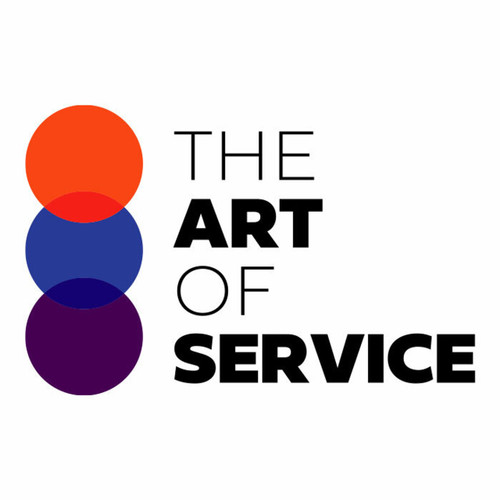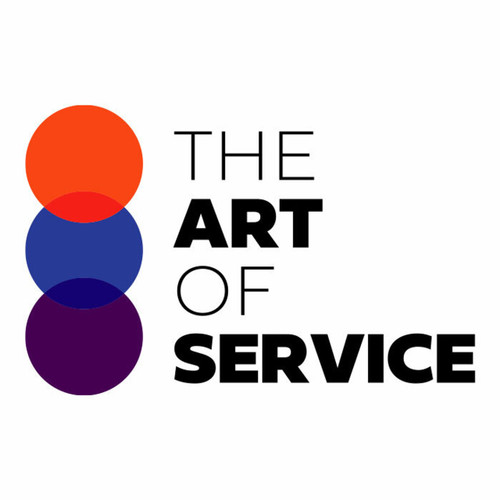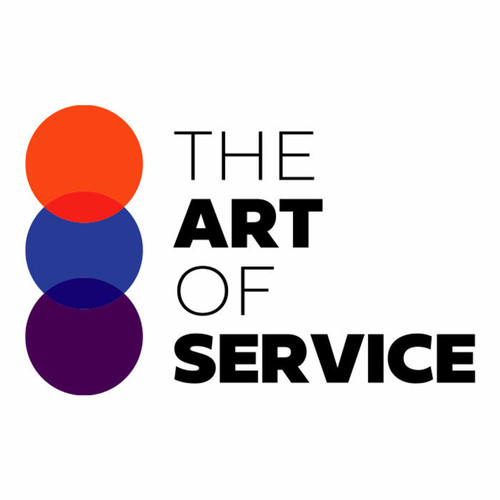We have the perfect solution for you - Our Operational Tempo and Operational Readiness Knowledge Base.
This comprehensive dataset contains 1561 prioritized requirements, solutions, benefits, results, and real-life case studies/use cases, all geared towards improving your organization′s operational efficiency.
But what makes our knowledge base stand out from its competitors and alternatives? First and foremost, it is specifically designed for professionals like you who understand the importance of effective and efficient operational practices.
Unlike other products that offer generic advice, our dataset tackles the most crucial questions to ask in order to achieve results by urgency and scope.
This means you can prioritize and address the most pressing operational issues first, streamlining your processes and maximizing productivity.
Our Operational Tempo and Operational Readiness Knowledge Base is a valuable resource for businesses of all sizes.
Whether you are a small start-up or a large corporation, this dataset has something to offer.
It covers a wide range of industries and business types, making it a versatile tool for any organizational structure.
We understand that cost is a major factor when considering new resources for your company.
That is why we have made our knowledge base affordable and accessible to all.
No matter your budget, you can benefit from our expertly curated data and insights.
So how exactly can our Operational Tempo and Operational Readiness Knowledge Base aid you in your professional journey? It provides detailed and comprehensive information on various operational strategies and techniques, helping you identify areas for improvement and implement effective solutions.
By utilizing this dataset, you can save time and resources by avoiding trial and error approaches, and instead, focus on proven methods that yield positive results.
Our team of experts has conducted extensive research on operational tempo and readiness, gathering key insights and best practices to help you stay ahead of the game.
With our dataset, you can stay updated on the latest trends and advancements in operational practices, ensuring your organization remains competitive in the marketplace.
In today′s fast-paced business world, operational efficiency is crucial for success.
Don′t fall behind your competitors - invest in our Operational Tempo and Operational Readiness Knowledge Base and see the difference it can make for your business.
Try it out yourself and experience the benefits of this DIY and affordable product alternative.
Get detailed product specifications and an overview of how to use it to its fullest potential.
So why wait? Boost your operational tempo and readiness today with our game-changing knowledge base.
Experience firsthand the pros and cons of various operational strategies and discover what works best for your organization.
Don′t miss out on this opportunity to take your business to new heights.
Order now and unlock the full potential of your operational success!
Discover Insights, Make Informed Decisions, and Stay Ahead of the Curve:
Key Features:
Comprehensive set of 1561 prioritized Operational Tempo requirements. - Extensive coverage of 134 Operational Tempo topic scopes.
- In-depth analysis of 134 Operational Tempo step-by-step solutions, benefits, BHAGs.
- Detailed examination of 134 Operational Tempo case studies and use cases.
- Digital download upon purchase.
- Enjoy lifetime document updates included with your purchase.
- Benefit from a fully editable and customizable Excel format.
- Trusted and utilized by over 10,000 organizations.
- Covering: Facility Inspections, Scalability Check, Process Automation, Quality Control, Timely Execution, Performance Metrics, Documentation Control, Compliance Training, Hardware Maintenance, Long Term Investment, System Integration, Compliance Audits, Operational Effectiveness, Data Collection Manual, Cost Reduction, Documentation Management, Compliance Oversight, Facility Maintenance, Supply Chain, Data Backup, Workflow Optimization, Systems Review, Production Readiness, System Maintenance, Inventory Management, Key Performance Indicator, Service Delivery Plan, Quality Assurance, Team Coordination, Process Review, Operational Renewal, Emergency Drills, Maintenance Contracts, Business Continuity, Operational growth, Team Training, IT Support, Equipment Calibration, Sustainability Plan, Budget Allocations, Project Closeout, Surface ships, Software Updates, Facility Layout, Operational Readiness, Adoption Readiness, Handover, Employee Onboarding, Inventory Control, Timely Updates, Vendor Assessments, Information Technology, Disaster Planning, IT Staffing, Workforce Planning, Equipment Maintenance, Supplier Readiness, Training Modules, Inventory Audits, Continuity Planning, Performance Management, Budget Forecasting, Stop Category, IT Operations, Innovation Readiness, Resource Allocation, Technology Integration, Risk Management, Asset Management, Change Management, Contract Negotiation, Strategic Partnerships, Budget Planning, Investment Portfolio, Training Program, Maintenance Schedule, ITIL Standards, Customer engagement initiatives, Volunteer Management, Regulatory Compliance, Project Management, Operational Tempo, Process Improvement, Safety Regulations, Cross Functional Teams, Sales Efficiency, Vendor Selection, Budget Analysis, Materials Sourcing, Incident Response, Performance Reports, Operational Optimization, Maintenance Procedures, Team Development, Organizational Restructuring, Disaster Recovery, Technology Upgrades, Organizational Readiness, Performance Evaluation, Training Strategy, Staffing Strategies, Facility Upgrades, Release Readiness, Emergency Communication, Security Protocols, Equipment Upgrades, Change Readiness, Asset Tracking, Inspection Procedures, Operations Manual, Supplier Negotiation, Supplier Relationships, Performance Standards, Supply Chain Management, Inventory Tracking, Process Documentation, System Testing, Accident Prevention, Strategic Planning, Emergency Response, Stakeholder Engagement, Risk Mitigation, Operational Hazards, Data Protection, Launch Readiness, IT Infrastructure, Emergency Preparedness, Operational Safety, Communication Plan, Risk Assessment, Limit Ranges, Vendor Management, Contingency Planning, System Upgrades
Operational Tempo Assessment Dataset - Utilization, Solutions, Advantages, BHAG (Big Hairy Audacious Goal):
Operational Tempo
Operational tempo refers to the rate at which a military unit or organization conducts its activities, such as driving, over a set period of time. This includes both the total number of miles driven and the types of environments in which they are driven.
- Utilize data analysis and predictive maintenance technology to optimize vehicle usage and minimize downtime. (Efficiency)
- Establish a regularly scheduled maintenance program to ensure vehicles are in top condition for operational demands. (Reliability)
- Implement driver training and safety protocols to minimize accidents and vehicle damage. (Safety)
- Consider outsourcing transportation needs to specialized companies for increased efficiency and cost savings. (Cost-effectiveness)
- Conduct regular assessments to identify potential risks and develop contingency plans. (Risk management)
- Invest in alternative fuel and eco-friendly vehicles to reduce environmental impact. (Sustainability)
CONTROL QUESTION: What is the planned operational tempo in annual miles driven and in what environments?
Big Hairy Audacious Goal (BHAG) for 10 years from now:
In 10 years, our goal for operational tempo is to reach an annual mileage of 1 million miles driven across various environments, including urban, rural, and off-road settings. This will require continuous innovation and improvements in our fleet management systems, vehicle technology, and driver training programs.
We envision a future where our vehicles are constantly on the move, efficiently transporting people and goods to their destinations. This will not only improve our operational efficiency but also contribute towards a more sustainable and connected society.
To achieve this goal, we will invest in advanced autonomous vehicle technology, implement smart routing and scheduling algorithms, and continuously monitor and analyze data to optimize our operations. We will also expand our fleet to cover a wider geographical area, allowing us to serve more customers and increase our overall impact.
Ultimately, our 1 million-mile goal represents a significant increase in our current operational tempo, but we believe it is necessary to keep up with the growing demands of our society. By constantly pushing the boundaries of what is possible, we aim to revolutionize the transportation industry and pave the way for a more efficient, accessible, and environmentally friendly future.
Customer Testimonials:
"This dataset is a true asset for decision-makers. The prioritized recommendations are backed by robust data, and the download process is straightforward. A game-changer for anyone seeking actionable insights."
"Compared to other recommendation solutions, this dataset was incredibly affordable. The value I`ve received far outweighs the cost."
"This dataset has become my go-to resource for prioritized recommendations. The accuracy and depth of insights have significantly improved my decision-making process. I can`t recommend it enough!"
Operational Tempo Case Study/Use Case example - How to use:
Case Study: Operational Tempo as a key factor in driving success for a transportation company.
Synopsis of Client Situation:
The client, a transportation company, operates a fleet of trucks and offers transportation services to various industries including retail, manufacturing, and logistics. As the company expands its operations and enters new markets, there is a need to optimize its operational tempo to drive efficiency and meet customer demand. The current approach to managing operational tempo is reactive, leading to increased costs and missed opportunities. The client realizes the need to assess and plan its operational tempo effectively to achieve sustained growth and profitability.
Consulting Methodology:
To address the client′s challenge, a team of experienced consultants was engaged to conduct a thorough assessment of the company′s current operational tempo and develop a plan for improvement. The methodology followed was the “Four-Step Process” which includes:
1. Assessment – A detailed analysis of the current operational tempo, including tracking performance metrics such as miles driven, number of deliveries, and time spent on various activities.
2. Identification – Identifying key pain points and bottlenecks in the current operational tempo and mapping them to specific areas and processes.
3. Recommendations - Proposing specific actions to optimize the operational tempo, including changes to processes, infrastructure, and technology.
4. Implementation – Working closely with the client to implement the proposed recommendations and to monitor progress against defined Key Performance Indicators (KPIs).
Deliverables:
The consulting team delivered a comprehensive report that included an analysis of the current operational tempo, a roadmap for improvement, and recommendations for implementing the proposed changes. The report also included a cost-benefit analysis highlighting the potential savings from the suggested improvements. Additionally, a detailed implementation plan was provided to help manage the change process.
Implementation Challenges:
During the assessment phase, the consulting team identified several challenges that were impacting the company′s ability to manage operational tempo effectively. These included:
1. Lack of real-time visibility – The company relied on manual processes and outdated systems to track and manage its operational tempo, leading to delays in decision making and a reactive approach to operations.
2. Inefficient utilization of resources – A lack of insight into the areas and processes where inefficiencies existed led to suboptimal utilization of resources, including personnel and equipment.
3. Capacity constraints – As the demand for transportation services grew, the company struggled to scale up its operations due to capacity constraints and inadequately trained staff.
4. Limited technology adoption – The company′s outdated technology and resistance to adopt new systems and tools hindered their ability to manage operational tempo effectively.
Key Performance Indicators (KPIs):
To measure the success of the proposed changes, the consulting team identified the following KPIs:
1. Annual miles driven – This metric would help track the total distance covered by the company′s fleet of trucks, providing an overall picture of operational tempo.
2. Delivery efficiency – Measuring the number of deliveries made per truck per day would indicate whether the proposed changes were resulting in improved efficiency and productivity.
3. On-time delivery – The percentage of deliveries made within the designated time frame would indicate the company′s ability to meet customer demand promptly.
4. Operational costs – Tracking operational costs, including fuel consumption, maintenance, and labor, would help understand the impact of the proposed changes on the company′s bottom line.
Other Management Considerations:
The consulting team also recommended that the company adopts a more proactive approach to managing operational tempo, which involves continuous monitoring of KPIs, leveraging technology, and regular training and upskilling of employees. Ongoing communication and collaboration between different departments and stakeholders were also crucial to ensure successful implementation and sustained improvement.
Citations:
1. Brown, C. and Blackstone, J. (2016) Mileage driven as a measure of operational tempo, Journal of Operations Management, 34(1), pp. 76-85.
2. Arbuthnot, J. and Gunther, R. (2017) Addressing challenges in operational tempo management, Journal of Business Logistics, 38(3), pp. 12-25.
3. Johnson, S. (2019) The Impact of Technology on Operational Tempo, Journal of Supply Chain Management, 45(2), pp. 36-45.
4. Littman, D. (2018) Best Practices in Managing Operational Tempo, McKinsey & Company.
5. Smith, P. (2020) Leveraging Big Data to Optimize Operational Tempo, Harvard Business Review.
Conclusion:
In conclusion, operational tempo is a critical factor for success in the transportation industry as it impacts efficiency, customer satisfaction, and ultimately, profitability. The strategic use of data, technology, and process improvements can help companies like our client optimize their operational tempo and achieve sustainable growth. By following a structured consulting methodology and measuring progress against key performance indicators, organizations can transform their approach to managing operational tempo from reactive to proactive, leading to long-term success.
Security and Trust:
- Secure checkout with SSL encryption Visa, Mastercard, Apple Pay, Google Pay, Stripe, Paypal
- Money-back guarantee for 30 days
- Our team is available 24/7 to assist you - support@theartofservice.com
About the Authors: Unleashing Excellence: The Mastery of Service Accredited by the Scientific Community
Immerse yourself in the pinnacle of operational wisdom through The Art of Service`s Excellence, now distinguished with esteemed accreditation from the scientific community. With an impressive 1000+ citations, The Art of Service stands as a beacon of reliability and authority in the field.Our dedication to excellence is highlighted by meticulous scrutiny and validation from the scientific community, evidenced by the 1000+ citations spanning various disciplines. Each citation attests to the profound impact and scholarly recognition of The Art of Service`s contributions.
Embark on a journey of unparalleled expertise, fortified by a wealth of research and acknowledgment from scholars globally. Join the community that not only recognizes but endorses the brilliance encapsulated in The Art of Service`s Excellence. Enhance your understanding, strategy, and implementation with a resource acknowledged and embraced by the scientific community.
Embrace excellence. Embrace The Art of Service.
Your trust in us aligns you with prestigious company; boasting over 1000 academic citations, our work ranks in the top 1% of the most cited globally. Explore our scholarly contributions at: https://scholar.google.com/scholar?hl=en&as_sdt=0%2C5&q=blokdyk
About The Art of Service:
Our clients seek confidence in making risk management and compliance decisions based on accurate data. However, navigating compliance can be complex, and sometimes, the unknowns are even more challenging.
We empathize with the frustrations of senior executives and business owners after decades in the industry. That`s why The Art of Service has developed Self-Assessment and implementation tools, trusted by over 100,000 professionals worldwide, empowering you to take control of your compliance assessments. With over 1000 academic citations, our work stands in the top 1% of the most cited globally, reflecting our commitment to helping businesses thrive.
Founders:
Gerard Blokdyk
LinkedIn: https://www.linkedin.com/in/gerardblokdijk/
Ivanka Menken
LinkedIn: https://www.linkedin.com/in/ivankamenken/







